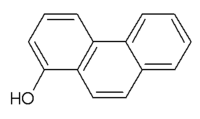1-Hydroxyphenanthrene
 | |
| Names | |
|---|---|
| IUPAC name
phenanthren-1-ol | |
| Other names
1-Phenanthrenol 1-Phenanthrol 1-hydroxy-phenanthrene | |
| Identifiers | |
| 2433-56-9 | |
| ChemSpider | 88945 |
| Jmol-3D images | Image |
| PubChem | 98490 |
| |
| Properties | |
| C14H10O | |
| Molar mass | 194.23 g/mol |
| Except where noted otherwise, data is given for materials in their standard state (at 25 °C (77 °F), 100 kPa) | |
| Infobox references | |
1-Hydroxyphenanthrene is a phenanthrol and a human metabolite of phenanthrene that can be detected in urine of persons exposed to PAHs.[1]
It can also be used as a marker for PAH pollution measured in marine fish bile.[2]
The model fungus Cunninghamella elegans produces, in the case of the biodegradation of phenanthrene, a glucoside conjugate of 1-hydroxyphenanthrene (phenanthrene 1-O-beta-glucose).[3]
Relationship with smoking
Highly significant differences and dose-response relationships with regard to cigarettes smoked per day were found for 2-, 3- and 4-hydroxyphenanthrene and 1-hydroxypyrene, but not for 1-hydroxyphenanthrene.[4]
References
- ↑ PAH metabolites (1-hydroxyphenanthrene, 4-hydroxyphenanthrene, 9-hydroxyphenanthrene, 1-hydroxypyrene). The MAK Collection for Occupational Health and Safety, Biomonitoring Methods, Vol. 6 (article)
- ↑ PAH Metabolites in Bile Fluids of Dab (Limanda limanda) and Flounder (Platichthys flesus): Spatial Distribution and Seasonal Changes. Ulrike Kammann, Environmental Science and Pollution Research - International, March 2007, Volume 14, Issue 2, pages 102-108, doi:10.1065/espr2006.05.308
- ↑ Cerniglia, C. E.; Campbell, W. L.; Freeman, J. P.; Evans, F. E. (1989). "Identification of a novel metabolite in phenanthrene metabolism by the fungus Cunninghamella elegans". Applied and environmental microbiology 55 (9): 2275–2279. PMC 203068. PMID 2802607.
- ↑ Urinary monohydroxylated phenanthrenes and hydroxypyrene – the effects of smoking habits and changes induced by smoking on monooxygenase-mediated metabolism. Heudorf U and Angerer J, International Archives of Occupational and Environmental Health, April 2001, Volume 74, Issue 3, pages 177-183, doi:10.1007/s004200000215
External links
| ||||||||||||||||||||||||||||||||